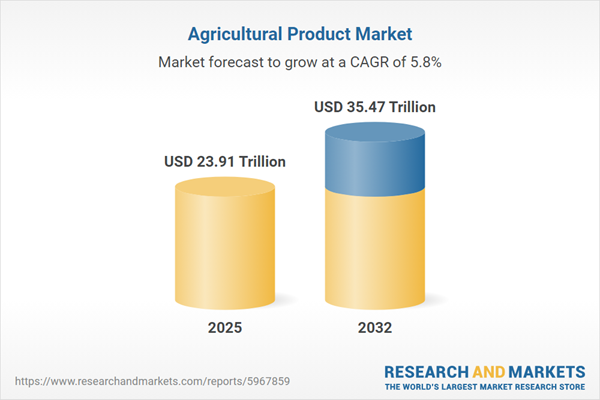Speak directly to the analyst to clarify any post sales queries you may have.
The agricultural product market is evolving swiftly as senior decision-makers address complex imperatives, integrating advanced technology and adapting to sustainability and regulatory shifts for strategic growth.
Market Snapshot: Agricultural Product Market Outlook
The agricultural product market is undergoing transformational change fueled by demographic trends, stricter regulatory oversight, and mounting sustainability requirements. Organizations are integrating next-generation fertilizers, innovative crop protection products, and adopting robust digital agriculture platforms. These developments are driving greater operational efficiency, traceability, and data-driven management practices throughout the industry. At the same time, the need to align environmental stewardship with operational effectiveness is influencing competitive strategy. As global supply chains become more interconnected, successful leaders are prioritizing agile responses that address varied regional dynamics and stakeholder needs through innovation and technology adoption. The market's trajectory demands forward-looking approaches that enable flexibility and resilience.
Scope & Segmentation in the Agricultural Product Market
This research provides targeted intelligence that supports effective technology adoption, strategic prioritization of high-growth geographies, and early identification of value-driven opportunities across the complete agricultural value chain:
- Product Types: Fertilizers such as biofertilizers, nitrogen-based, phosphate, and potash products; a spectrum of pesticides including herbicides, fungicides, insecticides, and rodenticides; agricultural machinery—tractors, planters, harvesters, irrigation systems; and advanced seed varieties for field, vegetable, and ornamental crops.
- Applications: Solutions for enhanced crop protection, precision nutrition management, modern irrigation strategies, and integrated soil conditioning, all aiming to boost crop resilience and drive productivity improvements.
- Crop Types: Addressing cereals, grains, oilseeds, pulses, fruits, and vegetables with a strategic focus on climate adaptability and advancing global food security.
- Distribution Channels: Multiple routes including direct and wholesale networks, specialty retail, and an increasingly vital digital channel comprising e-commerce and corporate on-site trading.
- Forms: Products supplied as coated or uncoated granulars, liquid emulsions and suspensions, or powders, supporting the efficiency and versatility of agricultural supply chains.
- End Users: Supporting commercial farms, service businesses, and smallholders, with resources for seamless technology integration and operational advancement.
- Regions: Coverage spans the Americas, Europe, Middle East and Africa, Asia-Pacific, as well as focused insights for China, India, Japan, and Southeast Asia, highlighting local regulatory and digital trends.
- Key Companies: Detailed analysis of Bayer Aktiengesellschaft, Corteva, Inc., BASF SE, Syngenta AG, FMC Corporation, UPL Limited, Nutrien Ltd, Yara International ASA, Sumitomo Chemical Co., Ltd., and Nufarm Limited, outlining strategic and technological leadership in the sector.
Key Takeaways for Senior Decision-Makers
- Build and refine agile supply chain strategies to respond effectively to frequent policy and market developments in various global regions.
- Adopt digital agriculture solutions and analytics platforms to improve transparency, strengthen data-driven insights, and enhance utilization of resources.
- Expand and diversify supplier networks, adopting dynamic procurement models to stabilize supply and mitigate evolving sourcing risks.
- Develop tailored product positioning and market entry plans that reflect local regulatory requirements and distinct marketplace drivers.
- Implement real-time monitoring systems to maintain readiness for regulatory and environmental change and enable faster executive actions.
- Engage proactively with technology providers and research partners to sustain innovation and maintain a decisive competitive edge.
Impact of 2025 U.S. Tariffs
The introduction of 2025 U.S. tariffs is causing a reevaluation of sourcing and supply strategies for agricultural sector stakeholders. Senior leaders must assess cost impacts, pursue new supply relationships, and realign operational processes to adapt to evolving trade policies. Emphasis on agile procurement and robust inventory controls is essential for maintaining business continuity and responding to regulatory shifts swiftly.
Research Methodology & Data Sources
This report’s findings draw from first-hand input gathered from producers, distributors, subject matter specialists, and regulatory authorities. Analyses are reinforced by public studies, academic work, and official government statistics, with advanced geographic and quantitative analytical methods informing high-level executive recommendations.
Why This Report Matters
- Enables executive teams to direct investments and strategic plans based on current risk profiles and shifting sustainability requirements in the agricultural product market.
- Supports organizations in achieving compliance and digital transformation goals for greater resilience and operational performance.
- Provides competitive insights and identifies action-oriented opportunities within agricultural supply chains.
Conclusion
Senior decision-makers can apply these market insights to adjust strategies, enhance risk controls, and prioritize innovation, ensuring effective responses to ongoing changes within the global agricultural sector.
Additional Product Information:
- Purchase of this report includes 1 year online access with quarterly updates.
- This report can be updated on request. Please contact our Customer Experience team using the Ask a Question widget on our website.
Table of Contents
3. Executive Summary
4. Market Overview
7. Cumulative Impact of Artificial Intelligence 2025
Companies Mentioned
The companies profiled in this Agricultural Product market report include:- Bayer Aktiengesellschaft
- Corteva, Inc.
- BASF SE
- Syngenta AG
- FMC Corporation
- UPL Limited
- Nutrien Ltd
- Yara International ASA
- Sumitomo Chemical Co., Ltd.
- Nufarm Limited
Table Information
| Report Attribute | Details |
|---|---|
| No. of Pages | 185 |
| Published | November 2025 |
| Forecast Period | 2025 - 2032 |
| Estimated Market Value ( USD | $ 23.91 Trillion |
| Forecasted Market Value ( USD | $ 35.47 Trillion |
| Compound Annual Growth Rate | 5.8% |
| Regions Covered | Global |
| No. of Companies Mentioned | 11 |









